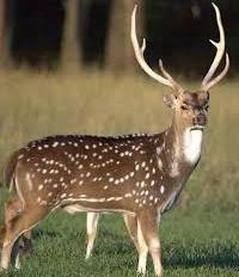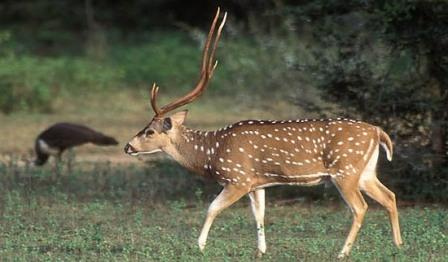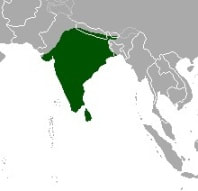Axis Deer (Chital, Cheetal, Spotted deer)Axis axis |

Custom Search
|
|
The Axis deer (Axis axis) locally known as chital or cheetal is an Asiatic deer species native to the Indian subcontinent. They belong to the family Cervidae and are the sole member of the genus Axis These deer are also sometimes referred to as Spotted Deer referring to their distinct spotted coat.
They are found obviously in India but also in several adjacent countries including Nepal, Bhutan, Bangladesh and Sri Lanka and was introduced in Pakistan. The Axis deer have also been introduced to many other parts of the world including Australia, Andaman Islands, and Papua New Guinea. In South America, it was introduced in Argentina, Chile, Mexico, Uruguay, Brazil, and Paraguay. In the United States, the introduced Axis deer is found in several states such as Alabama, Mississippi, Florida, Texas, Hawaiian Islands, and in Point Reyes National Seashore near San Francisco in California While in Europe the species was introduced to Armenia, Moldova, Ukraine, and Croatia's Brijuni islands. In their native range, the Axis deer is found in a variety of habitats, being only absent from extreme habitats such as dense evergreen forests or open semi-desert or desert. Their preferred habitat includes open areas as well as forested areas within their home range, which may incorporate a total area of about 195 ha for males and 140 ha for females. So the species is found in both moist and dry deciduous forest areas, riverine forests, coastal dry evergreen forests, short grasslands, swampy meadows and glades and mixed forests or plantations. Short grasslands are particularly important to these deer because they provide very little cover for large predators found in these habitats such as the Tiger (Panthera tigris).
The Axis deer has a reddish brown, brown or rust colored coat covered with white spots and a black stripe running along the spine. Their characteristic spots run longitudinally in rows and remain for their entire life, these spots are brighter on adults than on fawns.
Their belly, inner legs, ears, and underneath the tail are white, they also display a large white patch on the throat which is more prominent in males. Males are also usually darker than females and have black facial markings.The tail measures about 8 inches (20 cm) long and is marked with a dark stripe stretching along its length. The Axis deer is a medium-sized deer species standing at 60 cm to 95 cm tall at the shoulder, with a body length of about 1.5 m. Males are larger standing ate 29 to 39 inches tall and weighing from 150 to 250 lbs. While females reach only 26 to 33 inches tall but weigh quite a bit less than males ranging from 90 to 150 lbs. Only male Axis deer display antlers that gently sweep back into an upward curve with 3 points each. Their antlers most often reach about 20", but may reach 30" or more, with the current world record at 41" from India. Subspecies / Taxonomy / Etymology Today this deer species is considered monotypic, meaning there are no subspecies recognized. However, a 1951 paper divided them into 2 subspecies the Indian Axis deer (A. a. axis) and the Sri Lankan Axis deer (A. a. ceylonensis) but these are most often disputed and not considered valid. The German naturalist Johann Christian Polycarp Erxleben was the first to describe them in 1777. Diet / Feeding
The Axis deer a grazer when grasses and flowers which are their main food source are available. But it will become a browser as well if needed. In the winter months from October to January, they will mostly browse eating mainly shrubs, herbs, forbs, tree foliage, bark, and fruits fallen from the forest trees. Normally they eat the young shoots of grasses, but if unavailable they will nibble off the tips of tall and coarse grasses. Sometimes they will feed on strange items such as mushrooms in sal forests or even red crabs in the Sunderbans They also scrape mineral licks rich in calcium and phosphorus pentoxide with their incisors. Males are often seen standing on their hind legs to reach branches locate higher in trees. Usually the Axis deer will visit water holes twice a day, doing so with great caution since this is prime predator terrain. They usually tend to group together to graze and forage silently while moving slowly. Reproduction The Axis deer breeding season occurs all year long since females will regularly enter in oestrus cycles, which normally lasts 3 for weeks. However, there's a breeding peak around April or May but this will vary geographically. Size isn't that important since usually males with hard antlers dominate over those without antlers or in velvet despite their size. Occasionally, males may even kill each other when fighting over females. Rutting males will fast during the breeding season, following and guarding the female in oestrus during courtship. Before copulation, the pair will engage in several bouts of chasing each other and mutual licking. During the breeding season, the males also tend to bellow, which is a good indicator of the beginning of mating season. The gestation period lasts for about 7 to 8 months, usually, two fawns are born, but three or even just one is also a common occurrence. After birth females will hide the newborns for about a week nursing them until they can safely roam with the herd. This period is quite shorter than most other deer species and some African antelope species. Females are able to conceive again after 2 to 8 weeks after birth, so if a fawn dies, the mother can rapidly breed once again. Females reach sexual or reproductive maturity at 14 to 17 months of age while male need about 30 months. In captivity both the mating season and number of fawns born may differ from the wild, normally only one fawn is born while the mating season may last from May to August. Conservation status and major threats The Axis deer is listed by the IUCN as a "least concern" species due to its occurrence over a very wide geographic range where many large sub-populations still exist. They are protected both under the Indian Wildlife Protection Act and the Wildlife Preservation Act of Bangladesh. Ensuring the Axis deer conservation status are 2 main reasons their legal protection and a network protected areas where the species can thrive. Even though today there are no major threats to the Axis Deer, which is found in many protected areas this wasn't always the case. Up until the 1970's during the British rule of India and other countries, continuing after independence, there were substantial declines in Axis Deer populations as well as some local extinctions. This was caused mostly by hunting for their meat and extermination since they were regarded as an agricultural pest, habitat conversion to agriculture and competition with domestic livestock. This has led to population densities which are quite below the ecological carrying capacity of their habitat in many places. Today the species population is still declining in some areas, particularly those found outside protected areas. In 2010 it was estimated that in the Indian sub-continent the species has undergone an average extinction rate of 45% over the last half-century. But for now, their decline is nowhere near the rate required to qualify the species for listing as "Near Threatened". On the other hand, the Axis deer have also been successfully introduced to many places around the world such as Europe, South Asia, Australia, South America and North America. They have become an important species for sports hunters in the US where they were introduced into several states and while most individuals are found on private lands some have become free-ranging. Since the species does very well in captivity it can be seen at Zoos all over the world.
|
Did You Know?
The Alexandrine parakeet gets its name from Alexander the Great who exported them back to Europe. Scientific classification
Kingdom: Animalia Phylum: Chordata Class: Mammalia Order: Artiodactyla Family: Cervidae Subfamily: Cervinae Genus: Axis |



